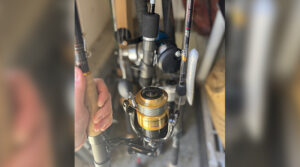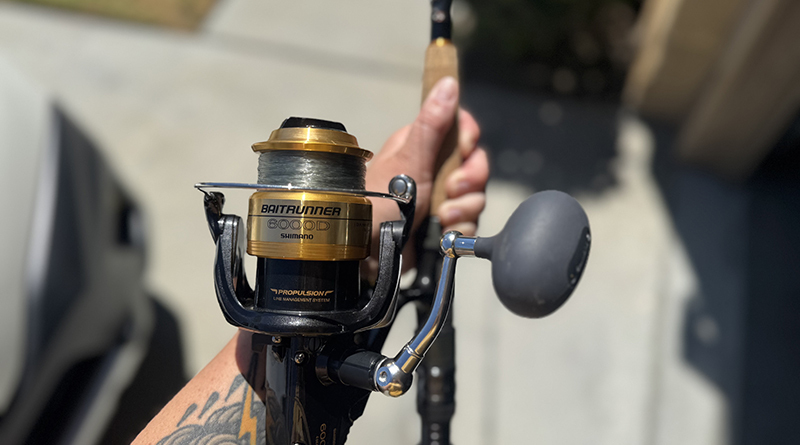Now, you might be used to The Log talking about boat maintenance a lot — and that’s because it’s without a doubt, very important. But that isn’t the only thing you should be keeping maintained.

Maintaining fishing gear may not be the most glamorous part of angling, but it’s absolutely one of the most important. For any angler hoping to get the most out of every cast and every fight, keeping rods, reels, line, and tackle in top shape is essential. Fishing gear takes a beating, especially in saltwater environments. Salt is particularly harsh, attracting moisture that eats away at metal parts and leaves corrosion in its wake. Combine that with sand, dirt, and daily wear and tear, and it’s easy to see how even quality equipment can quickly degrade if left unchecked. Without regular maintenance, reels can seize, drags can stick, guides can pit, and line can weaken — all of which could cost an angler that dream catch. Worse yet, neglected gear can become unsafe, as weakened line or rusty hooks can snap or break at inopportune times, posing risks to both angler and fish.
Caring for gear starts right after a trip, especially for those fishing in saltwater. A gentle rinse with freshwater removes surface salt deposits from rods, reels, guides, and terminal tackle. A light spray is key; high-pressure water can force salt deeper into reel internals, creating more problems than it solves. Once rinsed, a wipe-down with a damp cloth and mild soapy water helps lift any lingering grime, and letting everything air dry in a shaded, cool space ensures that trapped moisture doesn’t become a problem during storage.
Rod guides warrant close attention. These small but critical components can easily develop tiny cracks or corrosion pits that fray fishing line. A clever way to check their condition is to run a cotton swab through each guide; if fibers catch, there’s damage that could compromise performance. Reels also benefit from care beyond just rinsing. A drop of oil on moving parts like handle knobs, bail arms, and line rollers can keep them moving smoothly and ward off corrosion. Periodically, reels should be opened up for internal cleaning and lubrication. Applying a thin coat of reel grease on gears and drag systems can keep them operating properly, but it’s important not to overlubricate. Excess grease can gum up the works, making gears harder to turn and attracting dirt.
Some maintenance jobs are easily handled at home, like replacing old or damaged line. Lines should be replaced regularly, especially monofilament and fluorocarbon, which degrade faster than braid and can weaken with exposure to UV light and abrasion. Braided line holds up longer, but it too should be checked frequently for fraying, especially near knots and terminal tackle. Hooks, swivels, and lures all need attention as well. A rinse after saltwater use and proper drying before storage helps prevent rust, but it’s a good idea to sharpen hooks regularly to ensure they penetrate cleanly when a fish strikes.
While much of this upkeep can be handled by any angler at home, some jobs are better left to professionals. Full reel servicing — including disassembling reels, cleaning internal bearings, replacing seals, and calibrating drag systems — can be tricky and is best done by a tackle shop or reel technician. Repairing or replacing damaged rod guides is another example; while it’s possible to do at home, it requires specialized tools and know-how to ensure guides are perfectly aligned and secure.
Ignoring gear maintenance comes with consequences. Salt and corrosion will slowly but surely infiltrate moving parts, causing reels to seize or grind. Drag washers can stick, making it difficult to set proper drag pressure and risking break-offs on strong fish. Line weakened by neglect can snap under tension, and hooks dulled or corroded may fail to set properly. For an angler, few things are more frustrating than losing a fish due to gear failure that could have been easily prevented with a little regular care.
Every piece of gear deserves attention. Rod blanks and grips should be washed and inspected for cracks. Reel spools should be cleaned and checked for smooth operation. Guides should be cleaned and carefully examined for damage. Line should be rinsed, tested for strength, and replaced when signs of wear appear. Hooks and lures need to be cleaned, sharpened, and stored dry to prevent rust. Even small components like swivels, snaps, and split rings benefit from an occasional rinse and check.
A freshwater rinse is a good start, but it’s not a complete solution. Over time, salt can work its way into reel internals, corroding gears and bearings even if the exterior looks clean. That’s why lubrication and occasional deep cleaning are key parts of any maintenance routine. Most anglers can handle basic care themselves: rinsing gear, wiping it down, checking line and guides, oiling exposed moving parts, replacing line, and lubricating simple external components. For more complex servicing — like reel disassembly, internal bearing cleaning, drag washer inspection, and repair of damaged guides — it’s worth seeking professional help to ensure the job is done right.
There are plenty of small tips and tricks that can make a difference. Lubricating the roller bearing on spinning reels at least once a season is often overlooked but important, as this small roller reduces friction where the line passes over the bail. Less friction means less heat, and less heat means a stronger line that’s less likely to snap under pressure. Lubricating reel gears should be done carefully; too much grease can cause resistance and attract dirt, while a thin, even coat keeps things running smoothly. After every trip, inspecting conventional reels for loops or uneven line lay is wise, as even a small tangle buried deep in the spool can lead to disaster when a fish makes a long run.
Rod guides with rollers also need attention. Roller guides help reduce friction, but they need to spin freely to do their job. Sometimes that means removing tiny screws and parts to clean and lubricate them properly — a task that requires care but pays off in performance. Checking for tiny imperfections in guide liners is another smart step. The liners, often made of ceramic, can develop invisible cracks that fray line. A simple trick is to run a piece of pantyhose through each guide; if the fabric snags, the guide is damaged and should be replaced.
Even leaders can use some love. Coiled leaders often retain memory, creating loops and twists that affect performance. Hanging them with a weight for a week can help straighten them out. Hooks should not only be sharpened but also protected. After sharpening, coloring the point with a black marker helps prevent surface corrosion from forming on the exposed metal. Nylon filaments on lures can be cleaned to remove dirt and improve appearance, and combing out those filaments can make them look new again.
For anglers who fish with braid, reversing the line on the reel is a cost-saving trick. The line buried deep on the spool is often untouched and in excellent condition, while the line on top has seen the most wear. By transferring line from one reel to another, anglers can bring the fresher line to the surface without spending a dime. This technique doesn’t work as well for monofilament due to line twist, but a good practice with mono is to cut off the first 10 feet before every trip. That section takes the most abuse, rubbing on boat sides, getting tangled in nets, and absorbing stretch from fish, making it the weakest link in the system. Proper disposal of any discarded line is essential — anglers should always use appropriate receptacles to keep it out of the water and protect wildlife.
In the end, maintaining fishing gear isn’t just about protecting an investment — it’s about being prepared. When a fish strikes, you need to know your gear will work. With just a little time and attention between trips, anglers can be confident that every cast, every hookset, and every fight will be backed by tackle in peak condition. Regular cleaning, inspection, and maintenance not only extend the life of rods, reels, and tackle but also improves performance on the water, reduces frustration, and keeps the focus where it belongs — enjoying the next fishing adventure.





